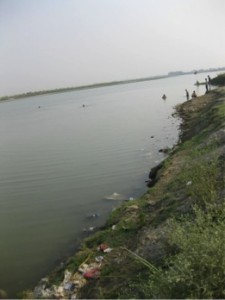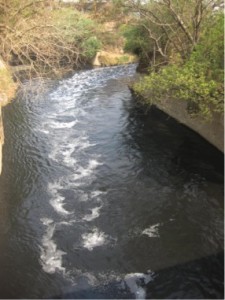June 2, 2013
Yamuna River Tour
The US contingent of this summer’s PIRE participants arrived in Delhi on the evening of May 31. We spent three whirlwind days getting a feel for the Delhi and India before joining our Indian counterparts at the IIT Kanpur campus on June 3rd. The 8 students from the US, each coming from disciplines as varied as political science to environmental engineering, were here to examine some of the most pressing social, health, and environmental challenges faced by urban communities in India.
On Sunday June 2 we pulled our jet-lagged bodies out of bed at 5:30am (anything to beat the heat!) and met up with Vimlendu Jha for a tour of the Yamuna River. Vimlendu is passionate about the Yamuna. He was recognized by CNN International’s Be The Change initiative for his ardent leadership to build citizen awareness and capacity for social/environmental problems in India.
Our Yamuna Walk consisted of 3 stops: one 5 km north of Delhi where the river is relatively clean, one stop 5 km downstream where the first of Delhi’s wastewater drains flows into the Yamuna, and the final stop 5 km further downstream where the river passes below a bridge.
 At our first stop we observed the river in a predominantly agricultural landscape. By our US standards, we would hesitate to call this a “clean” river, and certainly all of us would think twice before dipping a toe in this water. Nonetheless, we noticed several people bathing. A Delhi news crew joined our walk to film Vimlendu explaining the river’s many challenges for a local audience.
At our first stop we observed the river in a predominantly agricultural landscape. By our US standards, we would hesitate to call this a “clean” river, and certainly all of us would think twice before dipping a toe in this water. Nonetheless, we noticed several people bathing. A Delhi news crew joined our walk to film Vimlendu explaining the river’s many challenges for a local audience.
This summer I am participating in the inaugural year of an NSF Partnerships in International Research and Education (PIRE) grant “Developing Low-Carbon Cities in the USA, China & India through Inter-Disciplinary Integration Across Engineering, Environmental Sciences, Social Sciences & Public Health.” We start with the International Summer School on Sustainable Infrastructure-Sustainable Cities, which is offered to cohorts of graduate students from the US and India. I will spend the second half of the summer conducting research in rapidly urbanizing cities in South India on the first of the grant’s four themes: coupled water-energy-materials footprints of cities and industrial symbiosis as a way of reducing carbon emissions. The other three are (1) infrastructure interventions in electricity sector planning, bus rapid transit, and infrastructure upgrades in slums; (2) linkages between infrastructure, air pollution, and public health; and (3) social actors and governance of infrastructure toward sustainable and healthy cities.
The Yamuna River originates in the Himilayas, flows through Delhi, then passes by the Taj Majal in Agra before emptying into the Ganges River. The Yamuna provides about 70% of Delhi’s drinking water. Nearly 57 million Indians depend on the river, both upstream and downstream of Delhi. Vimlendu explained that water quality and quantity are both critical concerns for the Yamuna. During India’s Green Revolution focused on improving agricultural production, large dams diverted millions of gallons of water to irrigation. Low flow compounds the Yamuna’s water quality issues.
 At our second stop we witnessed the water quality from one of Delhi’s 15 wastewater drains that flow directly into the Yamuna. This water is treated by sewage and effluent treatment plants; however the foul smell, black color, and frothy bubbles of the water tell a different story. While Delhi does have a number of operating wastewater treatment plants, they are severely under capacity. Directly above the point where the drain flows into the Yamuna we saw the Wazirabad barrage. This dam manages waterflow to maintain drinking water supply for Delhi. On the day of our visit there was no water flowing over the barrage. This means that ALL the water flowing through Delhi is pure effluent from the sewage drains – 15 in total!
At our second stop we witnessed the water quality from one of Delhi’s 15 wastewater drains that flow directly into the Yamuna. This water is treated by sewage and effluent treatment plants; however the foul smell, black color, and frothy bubbles of the water tell a different story. While Delhi does have a number of operating wastewater treatment plants, they are severely under capacity. Directly above the point where the drain flows into the Yamuna we saw the Wazirabad barrage. This dam manages waterflow to maintain drinking water supply for Delhi. On the day of our visit there was no water flowing over the barrage. This means that ALL the water flowing through Delhi is pure effluent from the sewage drains – 15 in total!
At our third stop we viewed the river from a boat launch beneath a heavily trafficked bridge. Vimlendu explained that the municipality installed tall guardrails along the bridge because it used to be a popular spot for motorists to dump trash. Several bags of trash rained down from the bridge during our visit.
The Yamuna is one of the most sacred rivers in India. We stood on the banks of the black and smelly river along with an Indian couple who came to make an offering to the Yamuna. Their flowers floated out among the methane bubbles and litter, an ironic juxtaposition.
“There are many devotees in Vrindavana who regularly bathe in the Yamuna, and this cleanses all the contamination of the material world.” (Srimad Bhagavatam 5.8.31)
What are the necessary steps to bring the Yamuna back to a safe and healthy state? Vimlendu offers two:
1) Increase water flow through the barrages
2) Invest in effective sewage and effluent treatment plants that can handle the growing population
Vimlendu tells us that Delhi does have money and capability to fix this problem. If they can build a world class metro, they can clean a river. It’s a matter of citizen action and political will.
For more info, check out SWECHHA, a youth-run and youth-focused NGO founded by Vimlendu. SWECHHA uses awareness, communication, training and advocacy as tools for environmental and social development initiatives in India.
